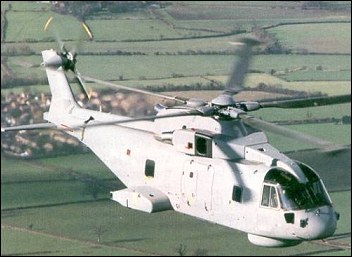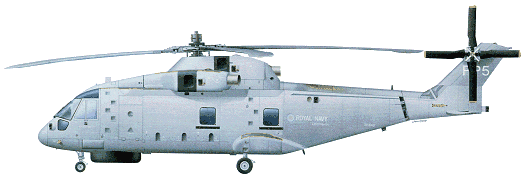
| European Helicopter EH-101 "Merlin" 19?? |  |
 |

| European Helicopter EH-101 "Merlin" 19?? |  |
 |
|
E.H. Industries Ltd is a joint partnership between GKN Westland Helicopters Ltd of Great Britain and Agusta of Italy to design and manufacture the EH-101 family of helicopters. This new, advanced technology helicopter has been designed to meet the demands for a medium lift helicopter undertaking both the civil and military roles. This includes the Heliliner, the civil variant EH-101 designed for commuter and offshore operations capable of carrying 30 passengers and baggage, or equivalent cargo, at 275km/h cruise speed over a 925km range in airline comfort and fixed-wing safety, with full day and night capability. There are two main military versions of EH-101, the Naval and Utility variants. In September 1991, the Royal Navy ordered 44 maritime EH-101/Merlins and on 9 March 1995 the UK Government confirmed an order for 22 EH-101 Support Helicopters/Utility variants for the Royal Air Force. The first production EH-101/Merlin are to be delivered to the Royal Navy in 1996. EH-101 has been designed, utilising worldwide market research, to meet the demands for a medium lift helicopter using all the latest aerospace technology currently available. Using a radical new approach in helicopter design and construction, EH-101's development and proving work proceeds side-by-side with the airframe, powerplant and rotor systems being test flown to both civil and military certification standards. This is the first time that a civil, military and naval variant of a major new airframe are evolving in a single integrated test programme. There are nine EH-101 pre-production aircraft, starting with PP.1 which first flew on 9 October 1987. The nine pre-production EH-101s are flying over 4000 hours of flight development and a 6000 hours maturity and reliability programme to ensure that EH-101 enters service as a fully proven helicopter. Pre-production aircraft include: PP.1, the first EH-101 and PP.2 the utility variant based in Italy which first flew in November 1987. PP.2 crashed in Italy on 28 January 1993 during a flight trial. PP.3, the first civil variant, flew in September 1988 followed by PP.6, the Italian Navy variant in May 1989. PP.4, the basic naval development aircraft, first flew at Yeovil in June 1989 and was later fitted with Rolls-Royce RTM322 engines. PP.4 was destroyed in a crash on 7 April 1995 during high-altitude trials. PP.5, the Royal Navy Merlin variant first flew in October 1989 followed by PP.7, the rear ramp basic military utility variant, which flew in Italy in December 1989. PP.8, the pre-production Heliliner, first flew in April 1990, followed by the last pre-production aircraft PP.9, which first flew in December 1990. PP.9 is fitted with a rear ramp and has been engaged in a variety of flight development trials including undertaking the civil certification, along with PP.8 who will undertake an extensive maturity programme. EH-101 design has made use of composites in both the fuselage and rotors and is powered by three engines, RTM-322s (2312 shp), GE CT7-6s or GE T700-401As. The advanced five-bladed rotor system, and newly-designed rotor head, is built around a titanium hub surrounded by composites allowing multiple load paths for greater safety and damage tolerance. The Naval variant has a powered tail- and blade-fold facility. The helicopter has a full computerised fuel management system, triple hydraulic systems, two MIL-STD 1553B multi-plex databuses and includes a comprehensive Health and Usage Monitoring System (HUMS). EH-101 has an advanced ergonomically designed "glass cockpit" with six high definition, full colour displays making for reduced pilot workload and an all weather operational capability. The digital automatic flight control system (AFCS) incorporates dual, duplex architecture providing automatic stabilisation and autopilot facilities, allowing single pilot operations in both VFR and IFR conditions. In the civil version, avionics also include two air data computers, AHRS, VOR/ILS, Marker Beacon System, Weather Radar, RAD ALT, ADF, ATCST, DME, Standby Compass, Artificial Horizon, Flight Management System, Hyperbolic Navigation and a Global Positioning System (GPS). EH-101/Merlin will give the Royal Navy an all weather maritime helicopter capable of operating from a frigate, day and night, in sea up to state six, winds of up to 90km/h and in icing conditions. With a fully integrated mission system, EH-101/Merlin can carry air-to-surface missiles and ASW weapons on the same mission and can be configured for many other tasks including anti-ship surveillance and tracking; airborne early warning; search and rescue; amphibious operations; exclusive zone operations and fishery protection or anti-smuggling roles. In the Utility/Support Helicopter role EH-101 can carry 30 combat troops, or lift internal freight weighing 4350kg or external loads up to 5000kg. The cabin can accommodate light vehicles, a light gun, crew and ammunition or 16 stretcher cases. P.Allen "The Helicopter", 1996
EH Industries was formed during June 1980 by Agusta of Italy and Westland of the UK to jointly design, develop and market an advanced military helicopter to supersede the basic Sikorsky S-61 design produced in Italy as the Agusta SH-3 and in the UK as the Sea King and Commando, all of which are in service with the British and Italian armed forces. Features of the EH 101 design include an advanced five-bladed main rotor and a four-bladed tail rotor; a tricycle landing gear retracting into fairings on the fuselage sides, and a powerplant comprising three turboshaft engines in a configuration chosen to ensure higher power reserves in the engine-out case. The military/utility version has a rear loading ramp. Three main variants are under development, the Merlin maritime version for the Royal Navy which will order 50, a similar maritime version for the Italian Navy which requires 42, but with increased emphasis on shore-based operations, and the Heliliner 30-seat commercial helicopter. In 1987 the EH 101 was selected as the New Shipborne Aircraft by the Canadian Navy which will buy 35 to replace its locally built Sea Kings, and the Royal Air Force has a requirement for 25 tactical transport versions. The first of nine pre-production prototypes made its first flight at Yeovil on 9 October 1987, followed by the second at Cascina Costa on 26 November. All nine EH 101s were flying by 1990, and entry into service is planned for the early 1990s. D.Donald "The Complete Encyclopedia of World Aircraft", 1997 
- The EH.101 prototype, with few of the features of the final aircraft, flew on 9 October 1987. - The Merlin makes extensive use of hi-tech composite materials. - The EH.101 will have a special 'harpoon' system for landing on frigate decks. - An Italian Merlin was lost in an accident on 21 January 1993, causing a brief delay in flight testing. - British Merlins will fly from the decks of Type 23 frigates like HMS Iron Duke. - Merlin production began at the rate of one new helicopter every seven weeks.
|